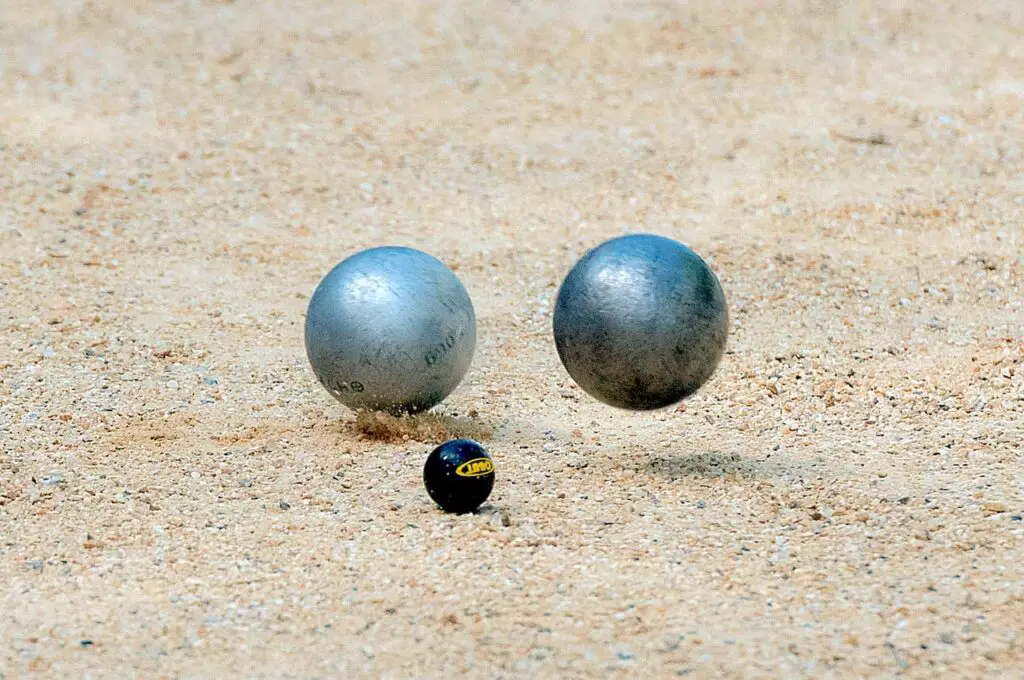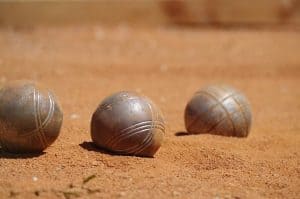Pétanque vs Bocce Ball – What’s the Difference?

What is Pétanque?
Pétanque vs Bocce Ball – what’s the difference? Pétanque is a boules-type sport.
Other boules-type sports include boule Lyonnaise, Raffa, and to some extent, crown green bowling and lawn bowls. Plus, there’s a somewhat similar game known as curling.
Though in curling, curling stones are used as opposed to balls or boules. And in curling, though the original game was played on iced-over lochs in Scotland, these days it’s played on, or in, an ice rink.
These sports are all similar in that each team, or each individual player, aims (using larger-sized boules – balls) at a smaller ball, which is the target.
In pétanque, the balls are made from either stainless steel or carbon steel.

In France, where the game of pétanque originated, the smaller target ball is known as the ‘but’. This literally translates to English as the ‘goal’. In English, however, the smaller-sized ball is called the jack.
The aim of pétanque is to reach 13 points. The team or individual player to score 13 points first is the winner.
The team/individual to have more boules closer to the ‘but’ or jack scores more points. Once every boule has been thrown the game ends and the next round begins.
Pétanque is played over a number of rounds. Rounds are generally referred to as ends. The team that scores the most in each end starts the next round.
The game of pétanque is not merely about ‘launching’ boules at the target to get as close as possible. Other tactics are frequently employed.
The removal of your opponents’ boules is one alternative method of winning the game. This is referred to as ‘shooting’.
Shooting tends to be the preferred method used at the sport’s higher levels.
Though pétanque is played purely as a social game in many locales, it’s relatively popular at the national and international levels.
Large events are held in many countries. Among the largest pétanque events are the Mondial La Marseillaise which is held in France, the La British Open, held in England, and the Amelia Island Open, which is held in the US.
Pétanque can be played on many different surfaces, though the surface needs to be fairly firm. Short grass is great. Unpaved backyards, too.
Pétanque has no true official rules given that, as many games are, it’s traditionally a pub game. As such, there’s no national governing body. Jessica over at frenchyourway.com.au does a fine job of providing rules for the game of pétanque.
The following video, brought to us by the English pétanque Association, introduces the basics of pétanque.
Bocce Ball vs Pétanque – What is Bocce?
Bocce’s origin dates back to 5000 years B.C. when it started in Egypt. The Greeks played bocce and more latterly, the Romans.
It is the Italians who are credited with how bocce is currently played. The word ‘bocce’ is plural for boccia – the Italian word for ‘ball’.
The game of bocce ball was a fascination for statesmen and rulers. Anyone from Leonardo di Vinci to Galileo to Queen Elizabeth of England were all fans of the sport.
Bocce ball was first played in the US in the 19th century by Italian immigrants.
The game of bocce ball consists of eight balls, half of which are of a different color.
The single, smaller-sized ball is referred to as the ‘pallino’.
Bocce, which must be played on a flat surface, can be played on grass, fine gravel, or some other similarly flat surface.
As many as four players can make up a single team. Nevertheless, so that every player has an equal opportunity to partake, teams are made up of four players, two players, or one player. On a per-frame basis, each player must throw four balls.
The key objective of bocce ball, which is similar to pétanque, is to get your balls as close to the pallino as possible.
When the game commences, a player from one team or the other throws the pallino. From this point on the goal is for each team to throw their bocce balls so they land as close to the pallino as possible.
After the first player throws their bocce ball, because their ball is closest to the pallino, they are said to be the ‘inside’. All other players are ‘outside’.
Once every player has thrown one bocce ball, the ‘inside’ player forfeits their opportunity to have another throw.
After all bocce balls have been thrown, the ‘inside’ is the person to be awarded points.
Players are awarded points for each ball closer to the pallino than the closest competitor’s ball. At which point it’s the conclusion of the frame. A further frame may now commence.
Prior to any bocce ball game starting a set number of points is established (typically 12 points). Once a player or team achieves this number of points the game has a winner.
As many frames as may be required can be played so that the agreed-upon number of points can be achieved.
(Official bocce ball rules by Bocce Standards Association).
The following video is about how to play bocce ball. I think it does a better job of explaining the game than I’ve done 🙂
Pétanque vs Boccia – What’s the Difference?
So, what Is the difference between the French game of pétanque and the Italian game of bocce?
Essentially, pétanque is more about the skill of tossing – similar to tossing horseshoes. Bocce, on the other hand, is more about bowling.
In pétanque, players don’t move prior to throwing. In bocce, players do move by taking steps.
The pétanque is tossed with a palm-down movement. The bocce ball is rolled in a palm-up movement. Pétanque balls achieve backspin when they are released. Bocce balls do not.
Pétanque balls are hollow, made from steel, and approximately the same size as an orange.
Bocce balls, though, are solid, around the same size as a grapefruit, typically (though not always) made of wood or resin, and are colored (red or green being the most popular colors).
You can play pétanque on almost any surface. Many players have a preference for an uneven playing surface as it’s more of a challenge.
The bocce court varies as to the layout and the size. But the bocce court must be flat and smooth. Some bocce rules denote that the court must be an enclosed area and so wooden sideboards are used.
Game tactics and point counting are very similar in pétanque and in bocce.
Generally, pétanque is said to be the more flexible of the two games. This is because a playing court is unnecessary and it’s easier to transport the equipment.
Pétanque Game Set from Pétanque America (the only U.S.-based official vendor that specializes in pétanque equipment)
Bocce Ball Set from AmazonBasics
Pétanque Court
As mentioned above, pétanque is more flexible in terms of the court than bocce because you can successfully play the game on many different types of surfaces.
It’s frequently played in parks and city squares without any requirement for a particular type of court.
There are, indeed, no specifications as to the exact pétanque court size. For FIPJP (International Pétanque Federation) there is, of course, a specified pétanque sanctioned competition court size:
Regional FIPJP competition pétanque courts: 10 x 40 feet/3 x 12 meters.
National and international sanctioned competitions must utilize a pétanque court that is minimum 13 x 50 feet/4 x 15 meters.
If you wish to build a pétanque court at home ideally the court would be a minimum of 10 x 40 feet/ 3 x 12 meters. This permits you to throw the jack up to 30 feet/10 meters. That’s the maximum legal distance.
How to build a pétanque court?
Here’s a link to a good PDF file providing a detailed account of how to build a pétanque court, otherwise referred to as a pétanque terrain.


